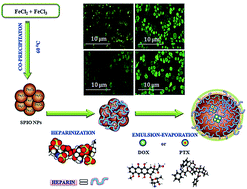Novel biodegradable heparin-coated nanocomposite system for targeted drug delivery
Abstract
Bare (∼10 nm) and heparin (HP)-coated superparamagnetic iron oxide nanoparticles (SPIO NPs; 42 nm) were formulated by a co-precipitation technique. The bare and HP–SPIO NPs had saturation magnetization of 50–55 emu g−1 at 300 K. The anticancer drugs, doxorubicin (DOX) and paclitaxel (PTX), were separately partitioned in the SPIO core to compare their anti-neoplastic effects on the proliferation of A2780 and OVCAR-3 human ovarian cancer cells. The results revealed that the DOX–HP–SPIO NPs (85 nm) and PTX–HP–SPIO NPs (71 nm) showed sustained and pH-sensitive release of DOX (87%) and PTX (75%), respectively, at pH 6.0, even up to two weeks. Meanwhile, 10 μg ml−1 DOX–HP–SPIO NPs and PTX–HP–SPIO NP caused 95 and 84%, and 85 and 77% apoptosis in A2780 and OVCAR-3 cells, respectively, with a sharp decrease in the level of bcl-2 and survivin proteins and increased expression of proapoptotic proteins, like bax and NF-κB. So, the presently formulated nanocomposite-based drug delivery system was readily internalized into tumor cells and induced a higher apoptosis rate.


 Please wait while we load your content...
Please wait while we load your content...